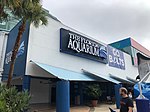Ybor City ( EE-bor) is a historic neighborhood that includes the Ybor City Historic District in Tampa, Florida. It is located just northeast of downtown Tampa and north of Port Tampa Bay. The neighborhood has distinct architectural, culinary, cultural, and historical legacy that reflects its multi-ethnic composition. It was unique in the American South as a prosperous manufacturing community built and populated almost entirely by immigrants.
Ybor City was founded as an independent town in 1885 by a group of cigar manufacturers led by Vicente Martinez-Ybor and was annexed by Tampa in 1887. The original population was mostly composed of Cuban and Spanish immigrants who worked in the cigar factories. Italian and Eastern-European Jewish immigrants followed shortly thereafter and established many retail shops, farms and grocery stores, box factories, print shops, and other enterprises which catered to the cigar industry and its workers.
Martinez-Ybor started the practice of building small houses, "casitas", that his workers could buy at cost, in order to increase staff retention. He also helped to ensure medical care and paved the local streets and sidewalks.The neighborhood grew rapidly during the 1890s, quickly evolving from a primitive outpost with streets of loose sand populated mainly by young Cuban and Spanish men seeking work into a bustling city with modern amenities and a diverse demographic makeup. During this decade, Ybor City's residents founded mutual aid societies, labor organizations, newspapers in several languages, and many other social and civic organizations along with a diverse roster of businesses, helping to create a vibrant civil society that blended the residents' different cultures of origin into a new "Latin" culture unique to Tampa. Ybor City continued to grow and prosper through the 1920s, by which time its factories were producing almost half a billion hand-rolled cigars every year, giving Tampa the nickname of the "Cigar City".
The coming of the Great Depression in the early 1930s brought a sharp reduction in the worldwide demand for fine cigars, and Ybor City's economic base suffered greatly. Some cigar factories closed, others ended the hand-rolled tradition and turned to mechanization to reduce costs, and remaining operations sharply decreased production and payrolls, resulting in widespread unemployment and hardship across the entire neighborhood. Demand for cigars increased after World War II, but by that time, almost all of Ybor City's cigar factories were mechanized and did not re-hire the skilled and well-paid artisans they had once employed by the thousands. As veterans returned from the war, they largely chose to leave the aging neighborhood for areas with better housing and economic prospects, accelerating the trend of declining population and economic contraction. This process accelerated further through the 1950s and 60s, when the federal Urban Renewal program and the construction of Interstate 4 resulted in the demolition of many structures, including hundreds of housing units. Planned redevelopment never took place, and, with its commercial district and social core virtually abandoned, Ybor City lapsed into a period of neglect and decay.
Beginning in the 1980s, the old business district centered on 7th Avenue (La Septima) began a slow recovery, first as a bohemian haven for artists and, by the early 1990s, as a popular nightlife and entertainment district. Since 2000, many historic structures near 7th Avenue have been renovated and restored, and construction has filled in most long-vacant lots. Among the new structures are hotels, office and retail space, and apartment complexes, leading to the Ybor City's first population increases in over half a century. Residential areas such as V.M. Ybor and Tampa Heights have also begun to see gentrification, with older structures being restored and new ones built.
While Ybor City's old business district and some nearby residential areas have been revitalized, not all of the original neighborhood has shared in the recovery. Poverty and blight are ongoing problems in portions of Greater Ybor City, especially north of I-4 and east of 22nd Street.





